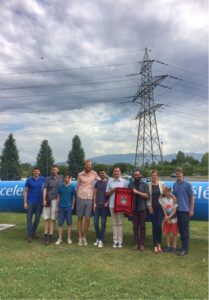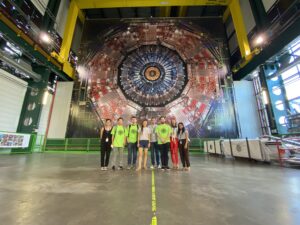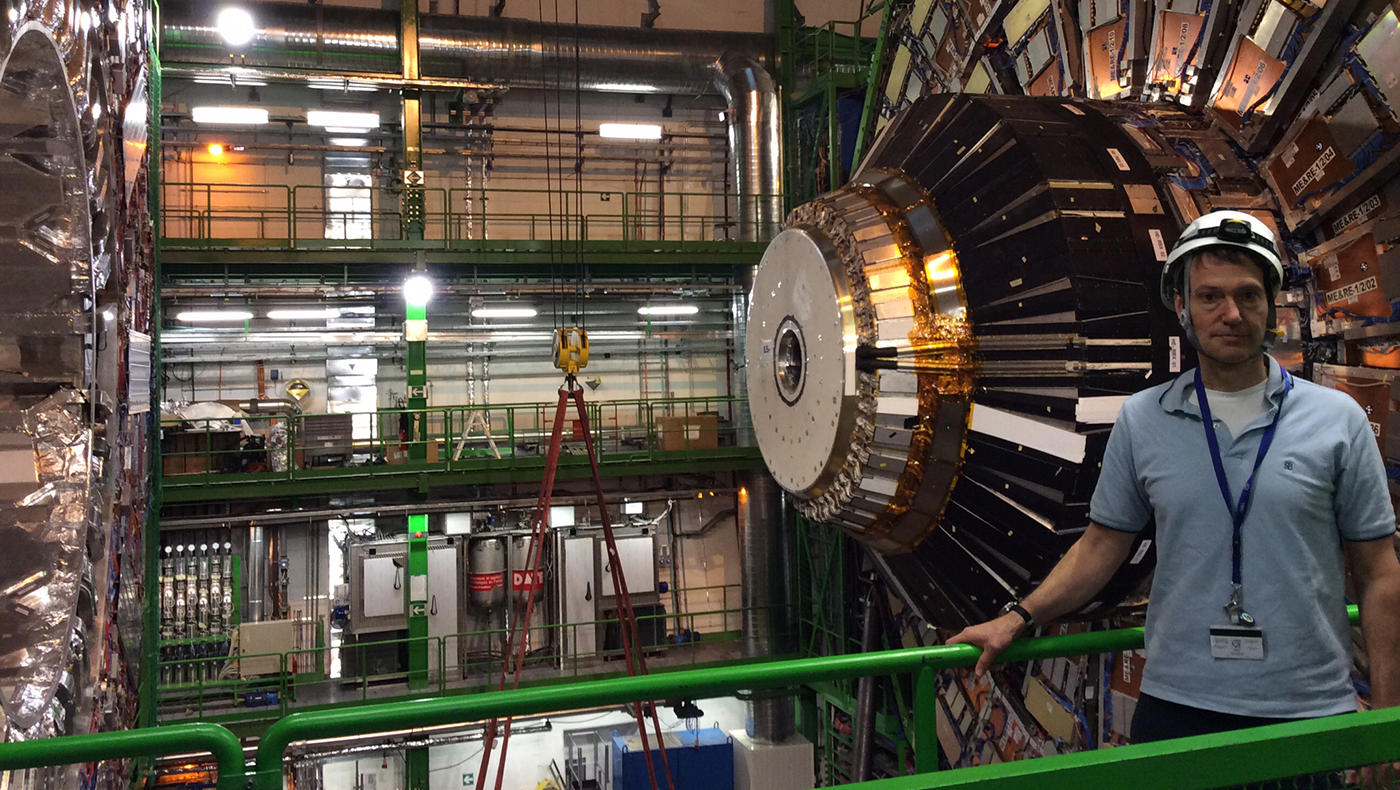Located at the European Organization for Nuclear Research (CERN) near Geneva, Switzerland, the Large Hadron Collider (LHC) is the world’s most powerful particle accelerator and is used to study elementary particles and their interactions. The Compact Muon Solenoid (CMS) experiment is a particle physics experiment conducted at the LHC and is one of the largest international scientific collaborations in history, including multiple Northeastern faculty members and students.
The CMS experiment is designed to investigate a wide range of physics phenomena, with a primary focus on the properties and behavior of particles like protons, electrons, and muons at extremely high energies. The experiment involves a CMS detector, a massive and complex instrument that surrounds one of the collision points of the LHC.

“[The LHC] is the most powerful microscope in the world,” says Emanuela Barberis, a professor in Northeastern’s Department of Physics. Barberis’ role in the CMS experiment is to work with the trigger system, the part of the LHC that makes decisions about what data to collect. Specifically, Barberis works on a detector of muons, a type of subatomic particle.
Based on how the muons bend in response to the magnets on the LHC, researchers can learn about them and their energy. From this knowledge, they can look for new phenomena like dark matter, explains Darien Wood, a professor in Northeastern’s Department of Physics. Wood’s work in the CMS experiment has included being the deputy system manager of the muon detector system, performing upgrades to the system to keep up with the increasing intensity of LHC experiments.
“[Dark Matter] is something we know is there. It’s very real. But we, as particle physicists, have no experimental evidence about what kind of particles it is [composed of]. So it’s a major mystery. It’s very exciting and there are a bunch of efforts going on to try to do direct detection of dark matter. And we think that maybe we can produce it directly at the LHC,” Wood adds.
The production of dark matter isn’t an unfair ask for the LHC. One of the most famous achievements of the LHC and CMS experiment was the discovery of the Higgs boson particle in 2012, a fundamental particle that plays a key role in giving mass to other particles.
“With this big experiment, we are able to tackle some very fundamental mysteries in physics that we can’t get out in any other way, which is what the discovery of the Higgs showed. Without this international collaboration, we would have never been able to discover it despite it being proposed for forty years,” Wood says.
Toyoko Orimoto, an associate professor of physics at Northeastern has worked closely with the Higgs boson particle throughout the CMS experiment.
“We’ve measured the [Higgs boson] properties inside and out and it looks very much like the particle it is expected to be. We also think the Higgs particle can potentially point us in the direction of physics to be discovered,” Orimoto describes.
Orimoto also works on the electromagnetic colorimeter, a part of the detector that precisely measures the energies of electrons and photons. In addition, Orimoto is working on building a new precision time detector that aims to handle a more challenging environment that will soon take place within the LHC.

A high luminosity adaptation to the LHC is the next step for the CMS experiment and will require significant upgrades to the current LHC detectors like the new precision time detector. The CMS experiment team received a National Science Foundation grant totaling over one million dollars to fund these upgrades, which Orimoto explains will increase the event rate of the particle collider.
Orimoto explains that increasing the event rate or ‘luminosity’ of the collider is an attempt to meet the need for as much data as possible to accurately evaluate the information found by the detector.
“In physics, the higher event rate doesn’t come for free, it comes with a really challenging environment and the [upgrades] will help us to optimally use that data and potentially also take us into new physics capabilities that we didn’t have previously,” Orimoto says.
Wood elaborates on this, describing the upgrades to the detector as a “bandwidth upgrade.”
“I use the analogy to a bandwidth upgrade because we need to get information out of this detector. If we want to see these very rare things that we’re looking for, we plan to massively increase the rate of collisions to five times what it was originally designed for … we don’t have the bandwidth right now,” Wood says.
Barberis echoes these sentiments and explains her team’s upgrades include the application of machine-learning techniques and artificial intelligence to make the detector’s decision-making algorithms more efficient.
However, this next step in the experiment does not come without challenges. The CMS experiment first started taking data in 2009 and parts of the CMS detector are over a decade old. Many of the researchers who built the original detector have since retired, so there is a new emphasis on training new generations to advance the detector.
 “The CMS is almost like a living creature and it has to be nurtured and fed to keep doing its best through all these years,” Wood says.
“The CMS is almost like a living creature and it has to be nurtured and fed to keep doing its best through all these years,” Wood says.
The role of the younger generation in the CMS experiment can not be understated. Barberis, Orimoto, and Wood each describe a collaborative and connected environment between them and the students they oversee at CERN.
“The students and researchers are going from undergraduate, graduate, and so on. They’re very excited to be there. I think that part of the experiment is a very important aspect of this work, it is an international collaboration, and you are exposed to a very collaborative, inclusive, and accepting environment,” Wood shares.
Barberis explains the complex and rewarding role of working on experiments and simultaneously training new generations on current and future experiments.
“We are always with a foot in the past, present, and future, and that spans several decades sometimes. It’s nice to see my former students end up as leaders in the CMS experiment, too,” Barberis says.
The enduring commitment and collaborative efforts of researchers like Barberis, Orimoto, Wood, and their successors guarantee the ongoing evolution of particle physics, shaping the understanding of the universe’s mysteries.

